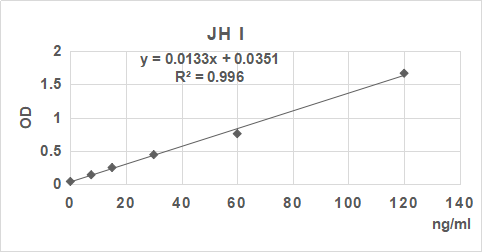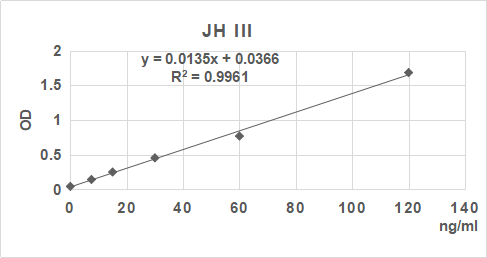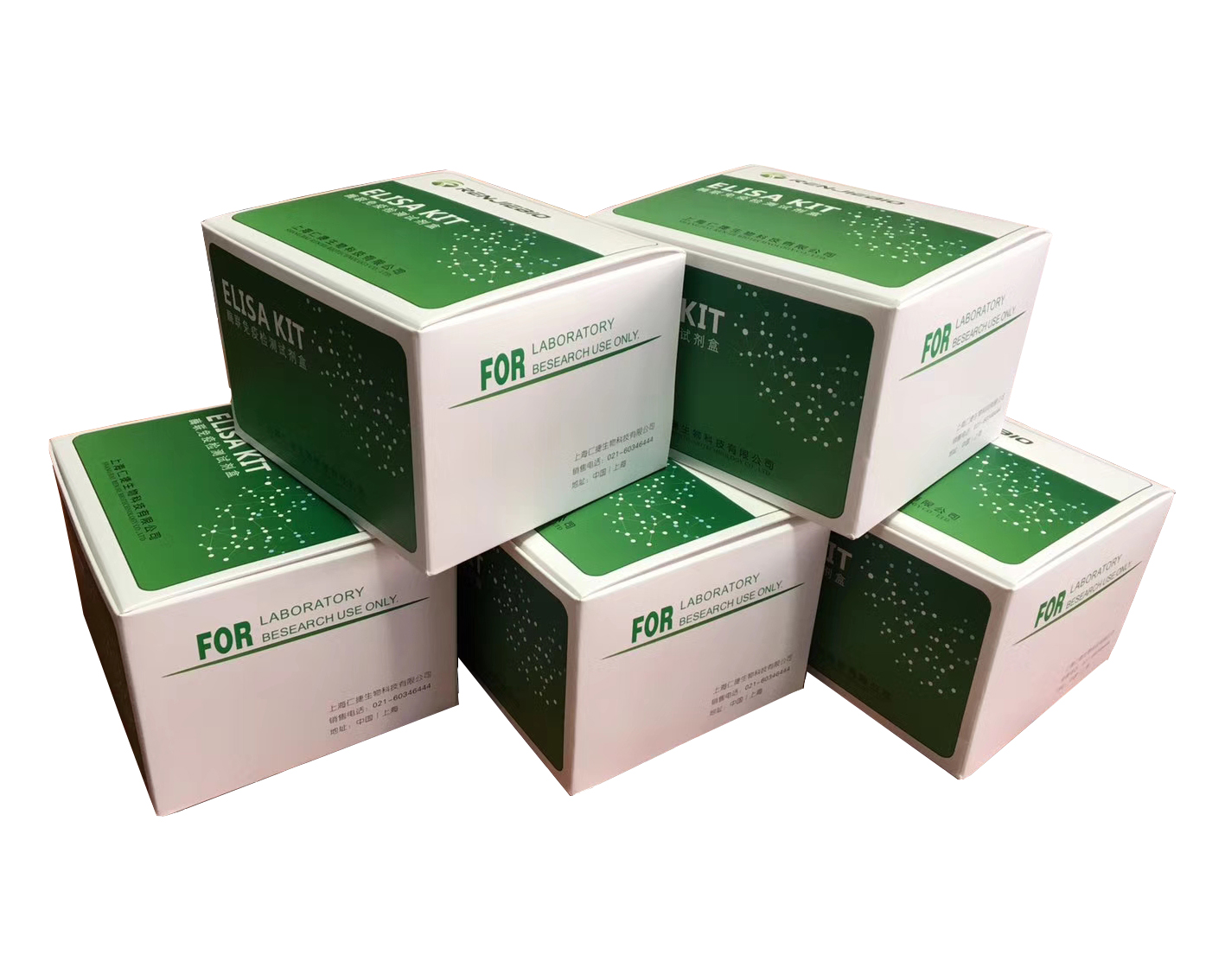暂无数据
中文说明书 UNIONHONEST
本品仅供研究使用 酶联免疫吸附测试 Enzyme linked lmmunosorbent Assay
昆虫保幼激素(JH)ELISA检测试剂盒
用 途: 用于昆虫血清、血浆及相关液体样本中保幼激素(JH)的测定。
检测原理
本试剂盒采用的是生物素双抗体夹心酶联免疫吸附法(ELISA)测定样品中昆虫保幼激素(JH)的水平。向预先包被了本公司自己制备多克隆抗体-(可识别JH1/JH2/JH3)的酶标孔中加入保幼激素(JH),温育;温育后,加入生物素标记的抗保幼激素(JH) 抗体,再与链霉亲和素-HRP结合,形成免疫复合物,再经过温育和洗涤,去除未结合的酶,然后加入底物A、B,产生蓝色,并在酸的作用下转化成最终的黄色。颜色的深浅与样品中昆虫保幼激素(JH)的浓度呈正相关。
试剂盒组成
|
| 名 称 | 96孔配置 12孔×8条 | 48孔配置 12孔×4条 | 备 注 |
| 1 | JH3标准品(240ng/ml) | 0.5ml | 0.5ml | 稀释即用型 |
| 2 | 酶标包被板 | 1块 | 1块 | 已包被即用型 |
| 3 | 标准品稀释液 | 3ml | 3ml | 即用型 |
| 4 | 链霉亲和素-HRP | 6ml | 3ml | 即用型 |
| 5 | 30x倍浓缩洗涤液 | 20ml | 20ml | 蒸馏水稀释 |
| 6 | 生物素标记的抗保幼激素(JH) 抗体 | 2ml | 2ml | 即用型 |
| 7 | 显色剂A液 | 6ml | 3ml | 即用型 |
| 8 | 显色剂B液 | 6ml | 3ml | 即用型 |
| 9 | 终止液 | 6ml | 3ml | 即用型 |
| 10 | 说明书 | 1份 | 1份 | 即用型 |
| 11 | 封板膜 | 2张 | 2张 | 不可反复使用 |
| 12 | 密封袋 | 1个 | 1个 | 即用型 |
JH3标准品来源:https://www.apexbio.cn/juvenile-hormone-iii.html
需要而未提供的试剂和器材
1. 酶标仪(450nm检测波长滤光片,570nm或630nm校正波长滤光片) 。
2. 洗板机(可调注液量,保证每孔洗液加至0.35ml而不溢出)。
3. 超净工作台,生物安全柜,通风柜。
4. 高精度单道加液器(量程为0.5-10μl, 2-20μl,20-200μl,200-1000μl).
5. 高精度多道加液器(8道或12道,量程为50-300μl).
6. 37℃恒温箱。
7. 低温离心机。
8. 电冰箱(4℃,-20℃,-86℃).
9. 漩涡混合仪,低频振荡器等
注意事项
1. 从2-8℃取出的试剂盒,在开启试剂盒之前要室温平衡至少30分钟。酶标包被板开封后如未用完,板条应装入密封袋中保存。
2. 严格按照说明书的操作进行,试验结果判定必须以酶标仪读数为准。
3. 为避免交叉污染,要避免重复使用手中的吸头和封板膜。
4. 不用的其它试剂应包装好或盖好。不同批号的试剂不要混用。保质前使用。
5. 底物B对光敏感,避免长时间暴露于光下。
6. 所有样品,洗涤液和各种废弃物都应按生物废弃物处理。终止液为2M硫酸,使用时必须注意安全。
7. 各步骤加样均应使用加样器,并经常校准其准确性,以避免试验误差。一次加样时间最好控制在5分钟内,如标本数量多,推荐使用排枪加样。
8. 每次试验测定的同时做标准曲线,。如标本中待测物质含量过高(样本OD值大于标准品孔最高浓度的OD值),请先用样品稀释液稀释一定倍数(n倍)后再测定,计算时请最后乘以总稀释倍数(×n)。
9. 配制试剂时,要用旋涡混合仪混匀。加入孔内的试剂,充分混匀对测试结果尤为重要,最好使用微量振荡器(使用最低频率),如无微量振荡器,可在反应前手工轻轻晃动酶标板1分钟,例如做圆周动作,使加入孔中的反应液混匀。
10. 实验用酶标仪应严格按使用说明书规范操作,并在使用前充分预热。
11. 手工洗板应注意:甩掉酶标板内的液体;在实验台上铺垫几层吸水纸,酶标板朝下用力拍几次;将稀释后的洗涤液至少0.35ml注入孔内,浸泡1-2分钟。根据需要,重复此过程数次。自动洗板:如果有自动洗板机,应在熟练使用后再用到正式实验过程中。
样本要求
1.不能检测含NaN3的样品,因NaN3抑制辣根过氧化物酶的(HRP)活性。
2.标本采集后尽早进行提取,提取按相关文献进行,提取后应尽快进行实验。若不能马上进行试验,可将标本放于-20℃保存或根据存放,时间做相应温度调整,但应避免反复冻融,(由于样本种类过多,每个单位处理方式不一样,本说明书不做详细介绍)。
操作程序
1. 标准品的稀释:(本试剂系统提供原倍标准品一支,用户请按照说明自行在小试管中倍比稀释)按下表格执行:
| 120ng/ml | (5号标准品) | 120μl的原倍标准品加入120μl的标准品稀释液 |
| 60ng/ml | (4号标准品) | 120μl的5号标准品加入120μl的标准品稀释液 |
| 30ng/ml | (3号标准品) | 120μl的4号标准品加入120μl的标准品稀释液 |
| 15ng/ml | (2号标准品) | 120μl的3号标准品加入120μl的标准品稀释液 |
| 7.5ng/ml | (1号标准品) | 120μl的2号标准品加入120μl的标准品稀释液 |
2. 根据待测样品数量加上标准品的数量决定所需的板条数。每个标准品和空白孔建议做复孔。每个样品根据自己的数量来定,能使用复孔的尽量做复孔。
3. 加样:1)空白孔:(空白对照孔不加样品,生物素标记的抗保幼激素(JH)抗体,链霉亲和素-HRP,其余各步操作相同 ;2)标准品孔:加入标准品50μl,链霉亲和素-HRP50μl(标准品中已事先整合好生物素标记抗体,故在操作时不加,只加链霉素-HRP);3)样本反应孔:加入样本40μl,然后各加入抗保幼激素(JH)抗体10μl、链霉亲和素-HRP(空白孔除外)50μl。盖上封板膜,轻轻振荡混匀,37℃温育60分钟。
4. 配液:将30倍浓缩洗涤液用蒸馏水30倍稀释后备用。20倍浓缩洗涤液用蒸馏水20倍稀释备用。
5. 洗涤:小心揭掉封板膜,弃去液体,甩干,每孔加满洗涤液,静置30秒后弃去,如此重复5次,拍干。
6. 显色:每孔先加入显色剂A 50μl,再加入显色剂B 50μl,轻轻震荡混匀,37℃避光显色10分钟。
7. 终止:每孔加终止液50μl,终止反应(此时蓝色立转黄色)。
8. 测定:以空白空调零,450nm波长依序测量各孔的吸光度(OD值)。 测定应在加终止液后10分钟以内进行。
结果判断
1. 每个标准品和标本的OD值应减去零孔的OD值。(若不减零孔值,标准曲线的零孔应相交于Y轴)
2. 根据标准品的浓度及对应的OD值计算出标准曲线的直线回归方程,再根据样品的OD值在回归方程上计算出对应的样品浓度。也可以使用各种熟悉应用软件来计算。
3.手工绘制标准曲线。以标准品浓度作横坐标,OD值作纵坐标,以平滑线连接各标准品的坐标点。通过标本的OD值可在标准曲线上查出其浓度。推荐使用专业制作曲线软件进行分析计算结果。
4.若标本OD值高于标准曲线上限,应适当稀释后重测,计算浓度时应乘以稀释倍数。
| 0.045 | 0.144 | 0.252 | 0.456 | 0.77 | 1.685 |
|
| 0 | 7.5 | 15 | 30 | 60 | 120 | ng/ml |
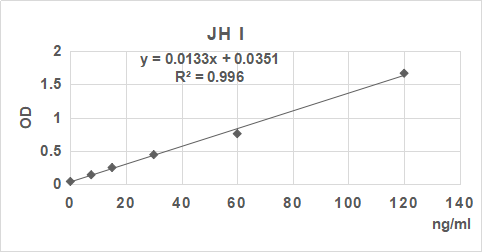
| 0.047 | 0.14 | 0.239 | 0.462 | 0.77 | 1.691 |
|
| 0 | 7.5 | 15 | 30 | 60 | 120 | ng/ml |
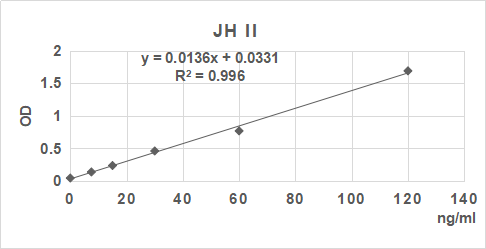
| 0.043 | 0.143 | 0.251 | 0.444 | 0.758 | 1.663 |
|
| 0 | 7.5 | 15 | 30 | 60 | 120 | ng/ml |
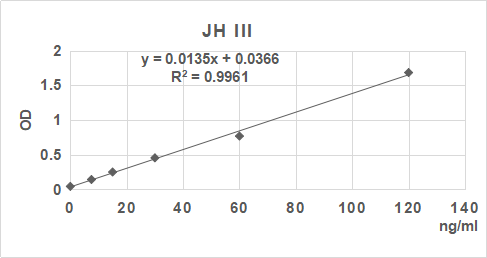
操作总结
准备试剂,样品和标准品
![]()
加入准备好的样品和标准品,生物素标记二抗和酶标试剂,37℃反应60分钟。
![]()
洗板5次,加入显色液A、B,37℃显色10分钟
![]()
加入TMB终止液
![]()
10分钟内酶标仪测OD值
![]()
计算待测样本因子含量
试剂盒性能
1. 准确性:标准品线性回归与预期浓度相关系数R值,大于等于0.9200。
2. 灵敏度:最小可检测浓度达,0.45ng/ml。
3. 特异性:不与其它可溶性结构类似物交叉反应。
4. 重复性:板内、板间变异系数均小于15%。
5 . 回收率:70-110%.
6. 贮藏:2-8℃,避光防潮保存。
7. 有效期:6个月
8. 检测范围:240ng/ml -1.875ng/ml
Insect juvenile hormone (JH) ELISA kit
Uses: For the determination of juvenile hormone (JH) in insect serum, plasma and related liquid samples.
Detection principle
This kit uses a biotin double antibody sandwich enzyme-linked immunosorbent assay (ELISA) to determine the level of insect juvenile hormone (JH) in the sample. Add juvenile hormone (JH) to the pre-coated polyclonal antibody (recognizing JH I/JH II/JH III) and incubate; after incubation, add biotin-labeled anti-juvenile hormone (JH) antibody, and then combined with streptavidin-HRP to form an immune complex, then incubate and wash to remove unbound enzymes, and then add substrates A and B to produce blue color, which is converted into the final yellow. The intensity of the color is positively correlated with the concentration of insect juvenile hormone (JH) in the sample.
Kit composition
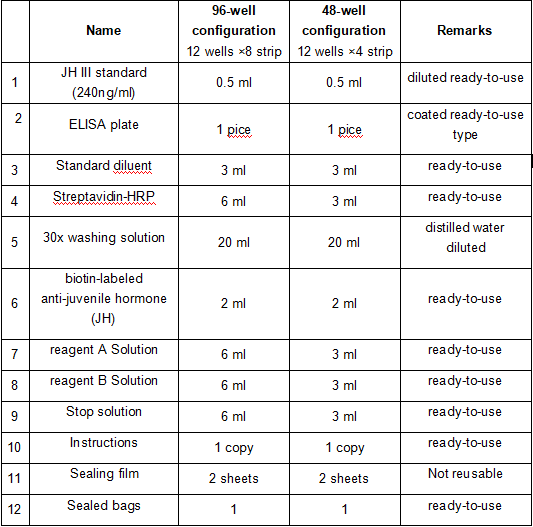
JH III standard:https://www.apexbio.cn/juvenile-hormone-iii.html
Materials required but not provided
1. Microplate reader (450 nm detection wavelength filter, 570 nm or 630 nm correction wavelength filter).
2. Plate washer (adjustable liquid injection volume to ensure that each well of washing liquid is added to 0.35 ml without overflow).
3. Ultra-clean workbench, biological safety cabinet, fume hood.
4. High-precision single-channel dosing device (range 0.5-10 μl, 2-20 μl, 20-200 μl, 200-1000 μl).
5. High-precision multi-channel dosing device (8 channels or 12 channels, 50-300 μl range).
6. 37℃ thermostat.
7. Low temperature centrifuge.
8. Refrigerator (4℃, -20℃, -86℃).
9. Vortex mixer, low frequency oscillator, etc.
Precautions
1. The kit taken out from 2-8℃ should be balanced at room temperature for at least 30 minutes before opening the kit. If the microliter plate is not used up after being unsealed by the plate, the lath should be stored in a sealed bag.
2. In strict accordance with the instructions, the test results must be judged by the readings of the Microplate reader.
3. In order to avoid cross-contamination, avoid reusing the pipette tips and sealing film.
4. Other reagents that are not used should be packed or covered. Do not mix different batches of reagents. Use before quality assurance.
5. Substrate B is sensitive to light to avoid prolonged exposure to light.
6. All samples, detergents and all kinds of wastes should be disposed of as biological wastes. The terminating solution is 2M sulfuric acid, and safety must be paid attention to when using it.
7. Samplers should be used in each step, and their accuracy should be calibrated frequently to avoid test errors. The time of adding a sample should be controlled within 5 minutes. If there are a large number of specimens, it is recommended to use pipette to add samples.
8. Make the standard curve at the same time of each test. If the content of the substance to be tested in the sample is too high (the OD value of the sample is greater than the OD value of the highest concentration of the standard hole), please first dilute the sample diluent by a certain multiple (n times) before determining it, and then multiply the total dilution multiple (× n) at last.
9. When preparing reagents, use a vortex mixer to mix well. The reagent added into the well is particularly important for the test results. It is best to use a trace oscillator (use the lowest frequency). If there is no trace oscillator, you can gently shake the elisa plate by hand for 1 minute before the reaction, such as circular movement, to mix the reaction solution in the well.
10. The Microplate reader for the experiment should operate strictly according to the operating instructions and be fully preheated before use.
11. Manual washing plate should pay attention to: get rid of the liquid in the elisa plate; lay several layers of absorbent paper on the test bench, and slap the plate down several times; at least pour the diluted detergent into the well and soak for 1-2 minutes. Repeat this process several times as needed. Automatic washing machine: if there is an automatic plate washing machine, it should be used in the formal experimental process after being proficient in use.
Sample requirement
1. The sample containing NaN3 could not be detected because NaN3 inhibited the (HRP) activity of horseradish peroxidase.
2. The samples should be extracted as soon as possible after collection, and the extraction should be carried out according to the relevant literature. If the test cannot be carried out immediately, the specimen can be stored at -20℃ or stored according to the storage time, and the corresponding temperature can be adjusted, but repeated freezing and thawing should be avoided.
Assy procedure
1. Dilution of the standard: (this reagent system provides one standard; users should follow the instructions to dilute the standard in a small test tube by themselves.) follow the table below:
| 120 ng/ml | (standard 5) | The original standard of 120 μ l is added to the diluent of 120 μ l of the standard. |
| 60 ng/ml | (standard 4) | 120 μ l of standard 5 is added to 120 μ l of standard dilution. |
| 30 ng/ml | (standard 3) | 120 μ l of standard 4 is added to 120 μ l of standard dilution. |
| 15 ng/ml | (standard 2) | 120 μ l of standard 3 is added to 120 μ l of standard dilution. |
| 7.5 ng/ml | (standard 1) | 120 μ l of standard 2 is added to 120 μ l of standard dilution. |
2. Determine the number of slats required according to the number of samples to be tested plus the number of standards. Double wells are recommended for each standard and blank well. Each sample is determined according to its own quantity, and multiple wells can be used as much as possible.
3. Add sample: 1) blank well: (blank well without sample, biotin-labeled anti-juvenile hormone (JH) antibody, streptavidin-HRP, other steps are the same; 2) standard well: add standard 50 μl, streptavidin-HRP 50 μl (biotin-labeled antibody has been integrated in advance in the standard, so do not add in the operation, only add streptomycin-HRP). 3) sample reaction well: add sample 40 μl, then add anti-juvenile hormone (JH) antibody 10 μl, streptavidin-HRP (except blank well) 50 μl. Cover the sealing film, gently shake and mix well, incubate at 37℃ for 60 minutes.
4. Mix liquid: wash solution (30x) will be diluted 30 times with distilled water. The wash solution (20x) diluted 20 times with distilled water.
5. Washing: carefully remove the sealing film, discard the liquid, shake dry, fill each hole with detergent, rest for 30 seconds and then discard, repeat 5 times, pat dry.
6. Color development: add chromogenic agent A 50 μl to each well, and then add chromogenic agent B 50 μl, gently shake and mix well, and avoid light at 37℃ for 10 minutes.
7. Termination: add 50 μl of terminating liquid to each hole to terminate the reaction (at this time, blue turns to yellow).
8. Measurement: the absorbance (OD value) of each well was measured sequentially with zero blank air conditioner and 450 nm wavelength. The determination should be carried out within 10 minutes after adding the terminator.
Result judgment
1. The OD value of each standard and specimen should be subtracted from the OD value of the zero well. (if the zero well value is not reduced, the zero well of the standard curve should intersect on the Y axis).
2. The linear regression equation of the standard curve is calculated according to the concentration of the standard sample and the corresponding OD value, and then the corresponding sample concentration is calculated on the regression equation according to the OD value of the sample. You can also use a variety of familiar applications to calculate.
3. Standard curve: The concentration of the standard is used as the abscissa, the OD value as the longitudinal coordinate, and the smooth line is used to connect the coordinate points of each standard. The OD value of the sample can be used to find out its concentration on the standard curve. It is recommended to use professional curve software to analyze and calculate the results.
4. If the OD value of the sample is higher than the upper limit of the standard curve, it should be diluted properly and retested, and the concentration should be multiplied by dilution multiple.
Operation summary
1. Prepare reagents, samples and standards.
2. The prepared samples and standards were added, and the biotin-labeled secondary antibodies and enzyme-labeled reagents were reacted at 37℃ for 60 minutes.
3. Wash plate 5 times and add chromogenic solution A and B to develop color at 37℃ for 10 minutes.
4. Add TMB Terminator.
5. OD value measured by Microplate reader within 10 minutes.
6. Calculate the factor content of the sample to be tested.
Kit performance
1. Accuracy: the correlation coefficient R between standard substance linear regression and expected concentration is greater than or equal to 0.9200.
2. Sensitivity: minimum detectable concentration, 0.45 ng/ml.
3. Specificity: does not cross-react with other soluble structural analogues.
4. Repeatability: the coefficient of variation within and between plates is less than 15%.
5. Recovery rate: 70-110%.
6. Storage: 2-8℃, keep away from light and moisture.
7. Validity period: 6 months.
8. Detection range: 240 ng/ml-1.875 ng/ml
9. Standard curve:
